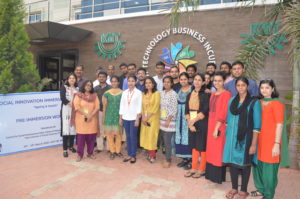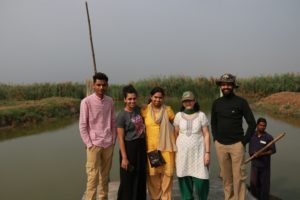“Journey is more beautiful than the destination reached!”
It is indeed true for the beautiful journey called life! It was an awesome experience for all the SIIP fellows under BIRAC grant programme focused on “Geriatrics and health”. As a part of our immersion programme, our first workshop was organized by one of the partners; KIIT-TBI at Bhubaneswar, Odisha. The purpose of the three days’ workshop was clearly mentioned and all the objectives were fulfilled because everybody religiously followed the schedule given by the speakers.
Sixteen young souls from four states with curiosity in their eyes, full of enthusiasm and innovative ideas in their minds were assembled together to talk about the problems and challenges faced by the older generation. One of the main objectives of the workshop was to orient all the sixteen fellows on the basics of “Social Entrepreneurship”. The speakers were experts from various fields, Social, Political and Entrepreneurial backgrounds and all of them are currently faculty members of Tata Institute of Social Science (TISS), Mumbai.
It is usually said that ‘well begun is half done!’ It actually happened in our case as our first workshop was a package full of knowledge, practise, long-hour discussions, home-assignments and group presentations. The best thing scholars asked us to follow was the shuffling of group members so that all the sixteen fellows were grouped into four groups and every group has one member from each state. Initially everybody was awkward as no one knew the other person and every group was diverse and unique in its own sense.
Dr. Mujumdar from TISS conducted first introductory session in which he put forth the objectives of the workshop and expectations from the fellows and what exactly we were about to learn. Dr. Guha, a social scientist from TISS talked about the social aspects of an ageing society and why it is necessary to think about the geriatric challenges India is going to face in a decade because of increasing ageing population. The demographic and health profile from Census and NSSO made an impact on the audience as the fellows understood the gravity of the issue after the presentation by Dr. Guha. It was a wise decision to introduce the fellows to various aspects of ageing on the first day itself; Dr. Reji from TISS illustrated the role of environmental factors in the ageing process. He showed a clip of an interview of a caregiver daughter who shared her experiences in the context of dementia care.
At the end of the first day, all the four groups were given a task of presenting what they understood from the sessions. Each group presented a scenario of ageing through their observations and experience. From this interactive session all the fellows intermingled with each other and that helped to know each other better.

Next two days were similar in nature where Dr. Mujumdar, Mr. Durvas, Dr. Guha and Dr. Reji conducted sessions on basics of social entrepreneurship. Being an interactive environment, all the fellows and the managers of all four groups got a fair chance to ask questions in between and express their thoughts on each of the component.
Gist of what we learnt from the WORKSHOP:
- ‘Innovation’ includes Invention (Newness), Adoption (Productive implementation) and Diffusion (Use of the idea in actual routine). Innovation is all about aspiration to find something new and an inspiration to pursue the goal even if you face failures.
- Innovator keeps on inventing new solutions, but an entrepreneur is someone who knows which solution must be provided in which setting and to which problem so as to have a sustainable business model.
- THREE Ps of Technology: a) Product b) Process c) PracticeProcess and Practice technology must be learnt and explored by both the innovator and the user. There are two types of technologies. One is upstream technology i.e. what is already present in the market. Second one is downstream technology meaning future products/technologies that would be coming into the market and are made by using the upstream technology.
- Studied basics of ‘Entrepreneurship’ through models like ‘Jeffry Timmon’s Model’, Kuratko’s framework. Entrepreneurship is a dynamic process and it is ‘opportunity driven’.
- In the context of ‘Gerontology’ which is a term coined by Metchinikoff in 1908, needs of people in the society should be considered by considering their backgrounds, culture, socioeconomics as these factors play an important role in the societal context.
- Environmental and political dimensions of old-age caring in India was taught by showing the most used frameworks like ‘epidemiological model of geriatrics’, ‘environmental press-competence model’ and ‘public health model of palliative care’ and so on.
- Two case studies were given to the fellows to understand about social entrepreneurship and which qualities an entrepreneur should have in him/her. Case studies given were of Dr. Narsimha Bhat (Manipal DotNet) and Ms. Neelima Mishra (Rural development through women empowerment).
- Role of every stakeholder (investors, co-founder, employees, and customers) is vital in entrepreneurship. An innovator should believe in himself and in the possibilities, only then he can become a successful entrepreneur.
Sometimes it is important to be together, be in a friendly environment and then people can be innovative as we all were creating our own stories for presentation. Even after studying for 9 hours, most of the fellows were enthusiastic about the home assignments. Personally, I enjoyed that feeling of being at hostel, studying in a group, enjoying local food and late night discussion with peers about not only future plans but also about nearby sights and blockbuster movies. I guess it is one of the best ways of learning i.e. learning together! I hope this bonding between the fellows would be helpful to explore the innovative solutions together!
After closing the session on the third day our team decided to visit Sun temple at Konark and Jagannath ji temple in Puri which is famous for its mystical wonders. We hired a car and visited both the temples at night. We enjoyed riding on that beautiful ‘marine drive’ road with canopies on one side and the ocean on the other. After taking darshan of Jagannath ji, we had dinner at “Panth Nivas” of OTDC and spent some time on one of the virgin beaches of Puri. Just before we reached Puri, first rain was already there. It was an amazing evening, converted into a magical night and it was a beautiful journey because I was travelling with my besties, I hardly knew them before the trip but one road trip has a potential to promise you a lifelong relationship! Now we certainly know each other and I am thankful to my manager for giving us this opportunity to be together and explore beautiful province of Odisha.
On 17th of March, we had a chance to visit Mangalajodi in Odisha, a village well developed into an ecotourism spot and they recently won the prestigious 14th UNWTO award in a ceremony held in Madrid, Spain for “Innovation in Tourism Enterprise”. It was an astounding experience of riding a boat in the wetland of Chilika lake, which is Asia’s largest brackish water lagoon was surrounded by flock of various water birds. What a moment when a pair of Ruddy Shelduck (Tadorna ferruginea) took a flight together! Speechless! What a beautiful colour combination! We observed various species of water birds such as Yellow Bittern, Black Bittern, Indian pond Heron, Grey Heron, purple Heron, Great White Pelican, Spot billed pelican, Yellow Bittern, Painted stork, Oriental darter, Pacific Golden Plover, Rufous treepie, kingfisher, Purple Swamphen and so on. Mr. Sanjib Sarangi, who has worked hard to achieve this grand success of ecotourism accompanied us throughout the ride.
Mr. Sanjib Sarangi, AVP & Head, National Rural Mission at Indian Grameen Services is an activist, an entrepreneur, an orator and a splendid person. He is the man behind the success story of Mangalajodi as he worked on his ideas by involving local communities and turned the heritage site into ecotourism model. Now Mr. Sarangi is working on scaling up of this project. Before meeting him we were looking at him as just a person who would be explaining us about the ecotourism and the migratory birds in the wetlands. However, after talking to him and knowing his inspirational story, I was so thrilled to see the steps he followed in his life were similar to what we learnt in the workshop. He is indeed an entrepreneur as he had a dream in his mind and he chased it in a way so that all the stakeholders; the government, the local poacher communities, the users and the young generation in Mangalajodi had obtained profit from his project. He believed in his heritage, he wanted to develop his village on a large scale so he targeted the key opinion leaders in the village, one of them was a poacher called Baabu aka Virappan (Due to his personality). This had a positive impact on the villagers because the leader was part of the village and the villagers respect him. Mr. Sarangi involved the Panchayat Raj at various levels. He made his awareness and promotion campaign through Gram Sabha so that the local communities agreed to be a part of his project and contributed in their own ways to develop the model. He built his team by taking dedicated professionals and the young minds. He himself did many of the courses and attended relevant workshops to find out what are the demands of current tourism industry and how he should do marketing of his ecotourism model to have maximum number of visitors from different parts of the world. I learnt three important things from Mr. Sarangi. First, one should believe in his/her dream. Second, one should establish networks in diverse fields to expand his/her own world and get exposed to the real world through this network. The last and the most important is, work hard to involve all the stakeholders actively & do not underestimate their contributions even if it is little as compared to the others.

It was like a meditation to be in that environment. Everything was so pure, so unique! After spending almost two and a half hour at Mangalajodi we headed to Bhubaneswar to catch our flight to Pune. Thankful to all the “stakeholders” for this wonderful trip!
